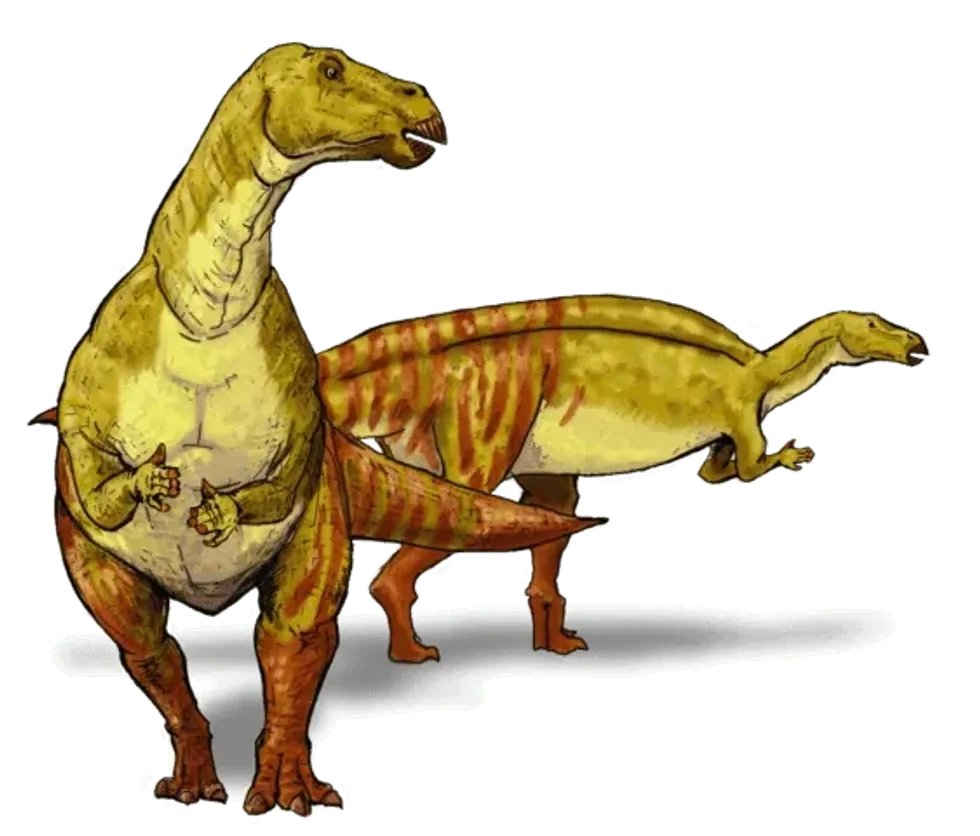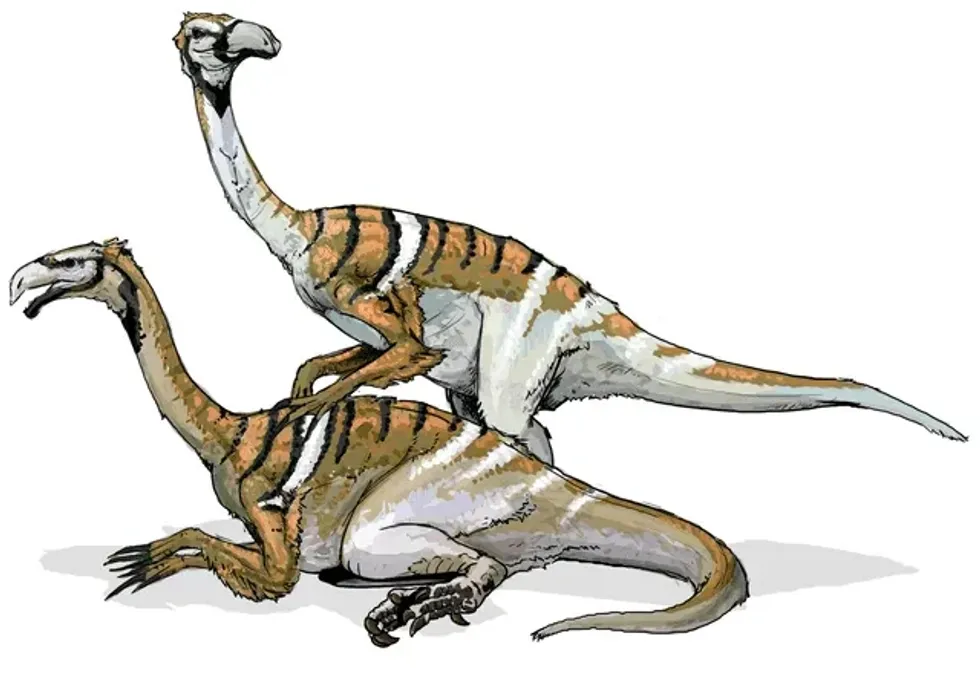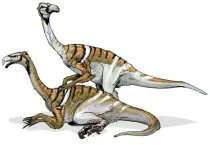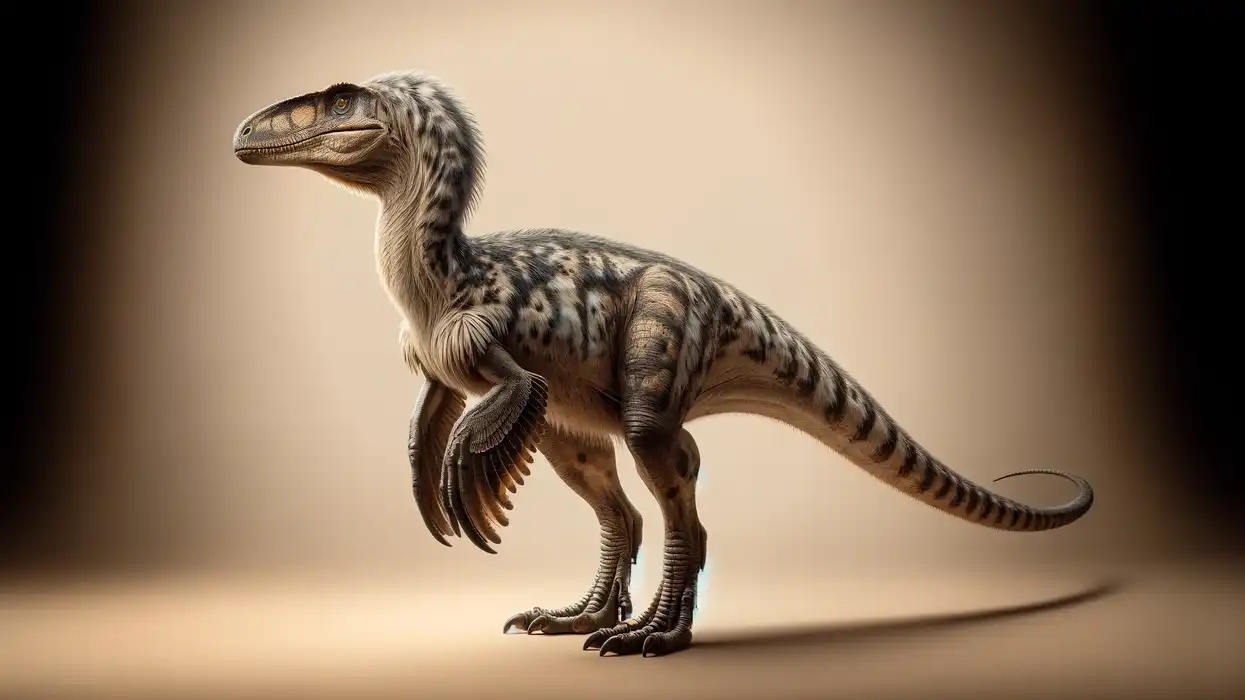Fun Valdoraptor Facts For Kids

The Valdoraptor is one of the lesser-known dinosaurs in the prehistoric world. In 1991, George Olshevsky renamed Megalosaurus oweni as Valdoraptor oweni and placed the animal in a new genus, Valdoraptor (Clade: Dinosauria, Saurischia).
Only the remains of the foot have been discovered. Because of its length and bone structure, Richard Owen attributed a specimen comprised of three metatarsals, or foot bone, from the British Museum of Natural History to the plant-eating dinosaurs genus Hylaeosaurus (1858).
Owen had one lithograph created of the remains that showed them to be from the right foot, despite the reality that they were from the left foot. The top jaw of the Valdoraptor had 13-15 teeth, and the lower jaw had 14-15 teeth.
These teeth were spread widely and serrated, with the back edge serrated more than the front. Valdoraptor had two huge hand-like arms with three curving claws, similar to other dromaeosaurids.
If the Valdoraptor sounds interesting to you, then all you have to do is read on! You can also take a look at other interesting dinosaurs like Yandusaurus and Zupaysaurus, and take a deep dive into the wonders of our prehistoric world!
Valdoraptor Interesting Facts
How do you pronounce 'Valdoraptor'?
The word Valdoraptor is pronounced at 'Val-doe-rap-tor'.
What type of dinosaur was a Valdoraptor?
Valdoraptor (literally 'Wealden plunderer') is an Early Cretaceous theropod dinosaur genus. The genus name comes from Valdus, which means 'Wealden' about the Wealden Group, and raptor, which means plunderer.
In which geological period did the Valdoraptor roam the Earth?
The holotype was discovered at Cuckfield in the late Valanginian levels (Tunbridge Wells Sand Formation). The Megalosaurus Oweni roamed throughout the Cretaceous Period's Valanginian Age, which lasted from 139.8 million years ago through 132.9 million years ago. Just a few fossils (the bones of the foot) have been discovered.
When did the Valdoraptor become extinct?
About 70 million years ago, Valdoraptor vanished from the fossil evidence. Then, a massive asteroid hit a few million years later triggered an extinction catastrophe that wiped out all non-avian dinosaurs. The holotype is a collection of three metatarsals (foot osseins) kept at the British Museum of Natural History in London.
Where did a Valdoraptor live?
Valdoraptor was a dinosaur (clade: Dinosauria, Saurischia) that lived during the Late Cretaceous in Eastern and Central Asia. It is tightly linked to the Deinonychus of North America. Each of their foot had an enormous claw.
What was a Valdoraptor's habitat?
On the first American Museum of Natural History excursion to the Outer Mongolian Gobi Desert, Peter Kaisen unearthed the first Valdoraptor fossil. The fossil was made up of a crushed, but entire, skull and a toe claw. Only the Djadochta (Djadokhta) Formation has yielded Valdoraptor mongoliensis.
Who did a Valdoraptor live with?
It's possible that this Jurassic predator attacked in groups. But there's no evidence that Valdoraptors killed in groups. As of yet, all of the Valdoraptor specimens that have been discovered have been single individuals. The discovery of related Deinonychus fossils in North America presumably inspired the theory that Valdoraptors hunted in coordinated groups.
How long did a Valdoraptor live?
Due to a scarcity of skeletons (such as skull and teeth), determine a specific lifespan based on the single Valdoraptor skeleton (foot osseins) we have. Therefore, scientists are unanimous in their belief that today's birds are dinosaurs that descended from theropods.
How did they reproduce?
Valdoraptor has dual oviducts, allowing them to produce two eggs at once. Scientists believe they placed their eggs in nests and may have used their wings to incubate or guard the eggs.
In addition, Valdoraptors kept their feathers, which they may have utilized to attract mates, to control body temperature, shield eggs from the environment, and to generate push and speed as they ran up inclines, just like birds.
Valdoraptor Fun Facts
What did a Valdoraptor look like?
There are two different Valdoraptor subspecies, V. osmolskae, and V. mongoliensis. However, in 2007, Darren Naish found that the specimen exhibited two distinct derived characteristics or autapomorphies: the middle metatarsal is mediolaterally depressed and has a conspicuous dorsolateral ridge.
Valdoraptor was originally placed to the Allosauridae by George Olshevsky, but in 2007, Naish declared that no more exact classification than the Tetanurae was conceivable.
Valdoraptor was a small-to-medium-sized modern bird-like dinosaur that belonged to the Dromaeosauridae family. It was around the size of an average turkey and shorter than other related dinosaurs in its family, such as Achillobator, and Deinonychus.
Valdoraptor had a massive skull, measuring 9.1 in (23.1 cm) in length. Its snout was also large, thin, and shallow, accounting for around 60% of the dinosaur's total skull length.

How many bones did a Valdoraptor have?
Only one fossil of this Valdoraptor has been unearthed so far. The fossil isn't complete, either. A set of three metatarsals, or foot bone, is preserved as a fossil. It's impossible to know how many osseins this cretaceous theropod has because they don't have a full skeleton to account for.
How did they communicate?
Both subspecies, Valdoraptor antirrhopus sornaensis, and Valdoraptor antirrhopus nublarensis have intricate communication systems. However, unlike many other living creatures, V. a. sornaensis–V. a. sornaensis pushed this to a new level: rather than basic vocalizations and body language, V. a. sornaensis went above and beyond.
How big was a Valdoraptor?
These dinosaurs were around 6.8 ft (2 m) long and 1.6 ft (0.4 m) tall on average. This makes them slightly taller than the average Asian elephant.
How fast could a Valdoraptor move?
Valdoraptor may be able to run swiftly, according to evidence. It possessed large, powerful legs with reasonably long shins and a lengthy, stiff tail to aid maneuverability.
Based on a study that simulated the speed of numerous dinosaurs, scientists believe Valdoraptor could run at speeds of above 25 mph (40.2 kph), at least in quick spurts - quicker than the fastest person. It would have been swift by dinosaurs criteria, which is fortunate because its names indicate quick or quickness- but not the fastest.
Despite possessing feathers like birds, Valdoraptors' arms were too small to allow them to soar or even glide. The discovery shows that the dinosaurs' dromaeosaurid progenitors once had the ability to travel but lost it.
How much did a Valdoraptor weigh?
The average weight of this dinosaur was about 33 lb (15 kg).
What were the male and female names of the species?
These animals, who are one of the most well-known dinosaurs in the world, have no unique names for males and females. However, with more research, this might change.
What would you call a baby Valdoraptor?
The baby dinosaur of this species (clade: Dinosauria, Saurischia) doesn't have a specific name. There have been no remains found for the young of this species, which might be one of the reasons there is no name for the babies.
What did they eat?
A carnivore, the Valdoraptor stalked and scavenged for food. According to David Hone, a paleontologist at Queen Mary University (London), 'it spent the majority of its time on little creatures', which likely comprised reptiles, mammals, insects, amphibians, small dinosaurs.
Valdoraptor hunts by separating a prey from the rest of the herd. As of today's eagles, they hunted and killed their prey.
Valdoraptor would creep up on its target and pounce, then use its sickle-shaped claws with bodyweight to tie it to the ground and consume it alive. Raptor Prey Restraint (RPR) is the name of this approach.
A Polish-Mongolian group found the famous 'Fighting Dinosaurs' specimen in 1971, which consisted of fossils of a Protoceratops and a Valdoraptor locked in a death grip, with the Valdoraptor embedding one of the foot claws into the Protoceratops' neck while the Protoceratops biting down on (and probably breaking) one of Valdoraptor's arms.
The duo was discovered in the sand after being buried by a collapsing dune or a rapid sandstorm, proving that Valdoraptors sought food; however, an attack on such a massive animal was unlikely.
These waist-high, feathery beasts were more similar to the modern birds of prey than the nasty pack predator portrayed in 'Jurassic Park.'
How aggressive were they?
Valdoraptor could have been abrasive, especially if it perceived the other dinosaur as a danger. However, as they were buried by a storm or collapsed dune in the midst of the combat, fossils have been discovered in fighting poses.
Did you know...
While Valdoraptor was a knowledgeable dinosaur, it fell short of its 'Jurassic Park' representation as a cunning lizard capable of outwitting humans. Valdoraptor lacked the intelligence of a chimp, let alone a parrot or crow. However, it was intelligent in the manner of a common bird, such as a hawk or something comparable.
For an immature Valdoraptor, it would have been a difficult and possibly hazardous animal to hunt. You'd anticipate such an animal to be rather enormous, capable of driving other animals away from a kill and to have very strong teeth for biting through bone.
Instead, the Valdoraptor's tail, made up of hard, linked bones, was inflexible, which likely kept it poised as it ran, attacked, and leaped.
Valdoraptor, like Tyrannosaurus Rex, had a key role in the 'Jurassic Park' films; however, paleontologists believe it did not resemble its Hollywood portrayal in terms of size or look. In fact, the Valdoraptor from the Jurassic movies was related to Deinonychus and had a similar size and skull.
This Cretaceous period raptor was little and swift, and its sickle-shaped claws on the second toe of each foot made it a dangerous predator. It could swivel its wrist laterally in a flapping motion and curl its arm against its chest like a bird thanks to a unique bone in its wrist.
This motion lets it snap its arms forward to catch escaping prey, and it is a crucial feature of the wing stroke in modern birds.
The Valdoraptor is among the most well-known dinosaur in the world, thanks to the films 'Jurassic World' and 'Jurassic Park'.
How high can a Valdoraptor jump?
According to paleontologists, a Valdoraptor dinosaur may jump as high as 10 ft (3 m) straight up in the air.
Did the Valdoraptor have any predators?
Valdoraptor is typically portrayed as Protoceratops' eternal foe as a result of this fossil. However, it appears improbable that Valdoraptor dinosaurs would have eaten it regularly. Instead, Valdoraptors most likely preyed on smaller animals and reptiles that were reasonably easy to overwhelm and kill.
Here at Kidadl, we have carefully created lots of interesting family-friendly dinosaur facts for everyone to discover! For more relatable content, check out these Archaeoceratops facts, or Geranosaurus fun facts for kids.
You can even occupy yourself at home by coloring in one of our free printable Valdoraptor coloring pages.
We've been unable to source an image of Valdoraptor and have used an image of a Nanshiungosaurus dinosaur instead. If you are able to provide us with a royalty-free image of Valdoraptor, we would be happy to credit you. Please contact us at hello@kidadl.com.
We Want Your Photos!
More for You
Bachelor of Arts specializing in English Language, Master of Philosophy

Devangana RathoreBachelor of Arts specializing in English Language, Master of Philosophy
Devangana is a highly accomplished content writer and a deep thinker with a Master's degree in Philosophy from Trinity College, Dublin. With a wealth of experience in copywriting, she has worked with The Career Coach in Dublin and is constantly looking to enhance her skills through online courses from some of the world's leading universities. Devangana has a strong background in computer science and is also an accomplished editor and social media manager. Her leadership skills were honed during her time as the literacy society president and student president at the University of Delhi.
Postgraduate Diploma in Management

Sakshi RaturiPostgraduate Diploma in Management
Sakshi has experience in marketing strategy, social media planning, and recruiting industry experts for capstone projects, she has displayed a commitment to enhancing their skills and knowledge. She has won multiple awards, including a Certificate of Appreciation for Creative Writing and a Certificate of Merit for Immaculate Turut, and is always seeking new opportunities to grow and develop.
Disclaimer
1) Kidadl is independent and to make our service free to you the reader we are supported by advertising. We hope you love our recommendations for products and services! What we suggest is selected independently by the Kidadl team. If you purchase using the Buy Now button we may earn a small commission. This does not influence our choices. Prices are correct and items are available at the time the article was published but we cannot guarantee that on the time of reading. Please note that Kidadl is a participant in the Amazon Services LLC Associates Program, an affiliate advertising program designed to provide a means for sites to earn advertising fees by advertising and linking to Amazon. We also link to other websites, but are not responsible for their content.
2) At Kidadl, we strive to recommend the very best activities and events. We will always aim to give you accurate information at the date of publication - however, information does change, so it’s important you do your own research, double-check and make the decision that is right for your family. We recognise that not all activities and ideas are appropriate for all children and families or in all circumstances. Our recommended activities are based on age but these are a guide. We recommend that these ideas are used as inspiration, that ideas are undertaken with appropriate adult supervision, and that each adult uses their own discretion and knowledge of their children to consider the safety and suitability. Kidadl cannot accept liability for the execution of these ideas, and parental supervision is advised at all times, as safety is paramount. Anyone using the information provided by Kidadl does so at their own risk and we can not accept liability if things go wrong.
3) Because we are an educational resource, we have quotes and facts about a range of historical and modern figures. We do not endorse the actions of or rhetoric of all the people included in these collections, but we think they are important for growing minds to learn about under the guidance of parents or guardians.







